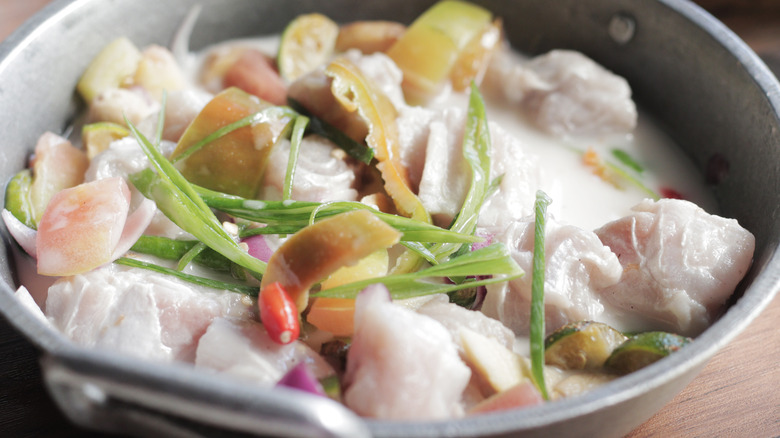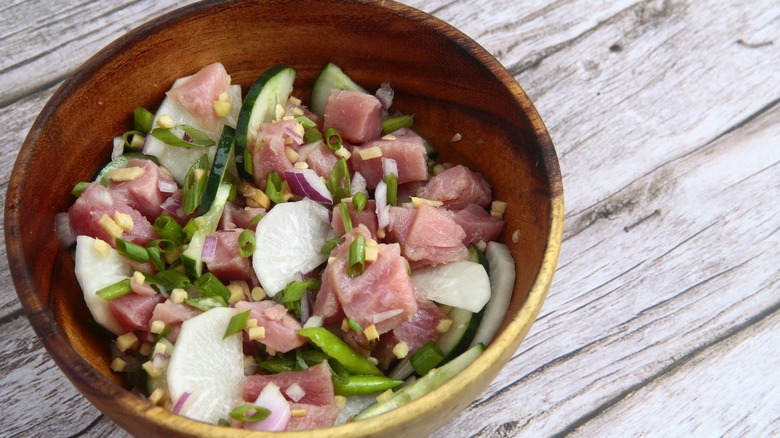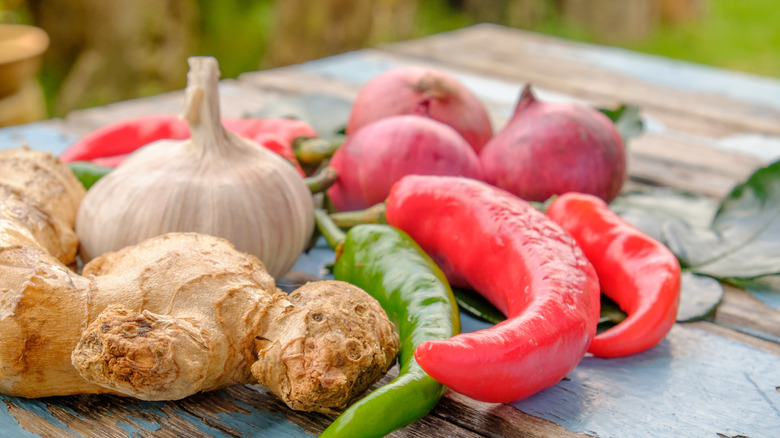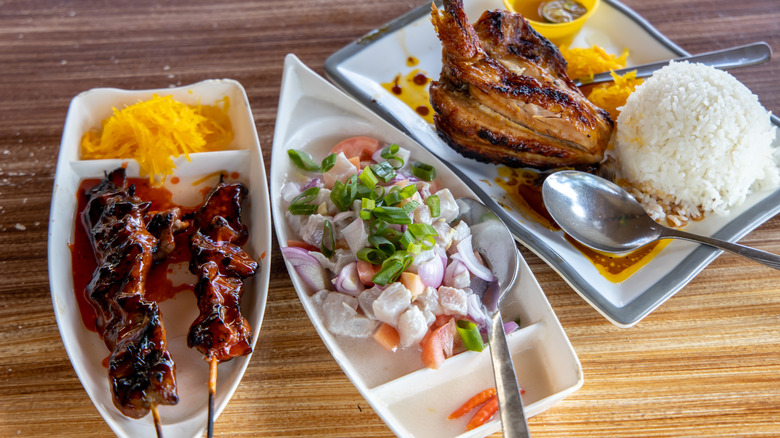Kinilaw: The Filipino Raw Fish Salad Ceviche Fans Should Know
Kinilaw is a dish of Philippine origins, where pieces of raw, cut-up seafood are given a quick soak in an acidic agent. While fish is predominantly used to make kinilaw, other types of seafood are used too. It is often compared to ceviche — the raw seafood dish tossed in citrus juice, which was likely first prepared and served about 2,000 years ago. And even though kinilaw isn't that old, archaeological records show kinilaw predates the Spanish invasion in the 1600s. One dictionary even describes kinilaw — or quilao as it was called — as the "adobo of the natives," per F&B Report. But unlike its South American counterpart, kinilaw doesn't rely on fruit acid — rather, it seeks out the country's local coconut vinegar to bring it to life.
The science behind kinilaw is identical to that involved in the making of ceviche. When seafood is exposed to heat, its protein threads — which are normally curled up into little balls — unfurl in a process known as denaturing. The same thing happens when seafood is exposed to acidic ingredients. And as they unfurl, they stick to each other or coagulate, and the seafood turns opaque. Fun fact: denaturing doesn't just happen to seafood — it happens to dairy too, which is how some cheeses like ricotta come to be.
Different types of kinilaw
As with other dishes native to the Philippines, like adobo, different variations of kinilaw exist around the country, all featuring one or two added ingredients that have changed the flavors and colors of each and every dish.
The oldest type of kinilaw, said to pre-date the Spanish colonial era, can be found in the southern Philippine region of Cagayan de Oro. Made with tuna, the kinilaw is tossed with a local fruit named tabon-tabon, as well as the tiny siling labuyo which is similar to bird's eye chili, cucumber, ginger, red onions, as well as vinegar.
Another type of kinilaw called the Negrense can be found in the province of Negros Occidental, which differentiates itself from other variations of this dish because it has a salted egg and features green mango, radish, onions, and a pinch of sugar, all bathed in local vinegar.
A third, known as La Reyna, is made creamy and rich with the addition of coconut milk. Chopped tomato, radish, cucumber, native chili, bell peppers, red onions, and spring onions bathed in vinegar round out this mouthwatering dish.
A fourth version that hails from the southern Philippine city of Davao includes bilimbi fruit and the indigenous Philippine lime known as calamansi; then there is one that sees the addition of a fruit found in parts of Southeast Asia known as the dungeon. There is also sinuglaw, which is kinilaw with a piece of grilled meat thrown on top.
The ingredients you'll need to make kinilaw
As with buying the right fish to make ceviche, getting the freshest seafood is vital to getting your kinilaw right. This means the seafood — be it fish, shrimp, or oyster — cannot have a fishy smell, and its flesh needs to appear translucent. If you give the fish a poke, its flesh will remain intact, and the best way to get this is to make use of sushi-grade seafood. Types of fish that make good kinilaw include Spanish mackerel, known locally as tanigue, as well as yellowfin tuna. Other firm-fleshed fish that would work include marlin, black surgeonfish, and dolphinfish. If none of these are options, other seafood, including crabs and oysters, will work too — as long as they are fresh.
Another ingredient that makes kinilaw what it is, is native Philippine vinegar, although just what that means depends on where the kinilaw is made. Coconut vinegar is a popular choice, as is sugarcane vinegar. Some styles of kinilaw might use sour fruit to trigger the acid reaction needed to "cook" the seafood, from native limes to green mangoes.
But there are still flavors that can be found across all types of kinilaw, and these are ginger, onions, bird's eye chili, as well as a bit of salt.
There are many ways to make kinilaw
Making kinilaw can be as much of an ad hoc experience as making adobo can be. Foxy Folksy's version of this Filipino classic calls for a cup of vinegar, citrus, ginger, red onion, and chili, while Serious Eats recommends the addition of mango, coconut milk, and the use of spiced coconut milk. The version put forward by New York restauranteurs and Purple Yam owners Amy Besa and Romy Dorotan in their book "Memories of Philippine Kitchens" recommends the making of a vinaigrette made with olive oil, lime juice, and rice vinegar to be used with steamed lobsters.
When making kinilaw with raw fish, Besa and Dorotan also emphasize the importance of marinating the fish, as opposed to soaking it in the acid — which you might do with a ceviche. Keeping it in the marinade for too long will make the fish chalky before it disintegrates, which is the last thing you want with a dish meant to showcase the freshness of its ingredients.
Kinilaw can be served as an appetizer or a light main course with other dishes.



